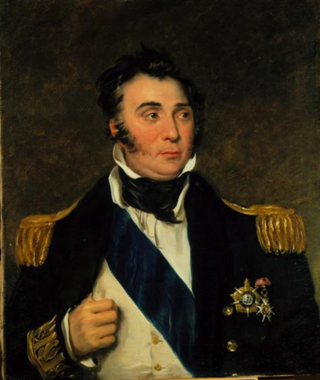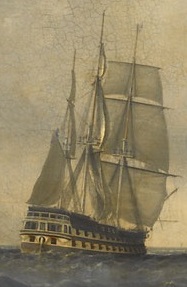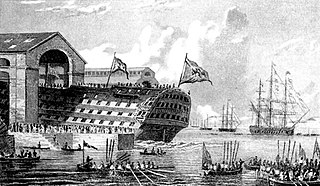
Bakumatsu was the final years of the Edo period when the Tokugawa shogunate ended. Between 1853 and 1867, Japan ended its isolationist foreign policy known as sakoku and changed from a feudal Tokugawa shogunate to the modern empire of the Meiji government. The major ideological-political divide during this period was between the pro-imperial nationalists called ishin shishi and the shogunate forces, which included the elite shinsengumi swordsmen.

The Shimonoseki campaign was a series of military engagements in 1863 and 1864, fought to control the Shimonoseki Straits of Japan by joint naval forces from Great Britain, France, the Netherlands, and the United States, against the Japanese feudal domain of Chōshū, which took place off and on the coast of Shimonoseki, Japan.

HMS Duke of Wellington was a 131-gun first-rate ship of the line of the Royal Navy. Launched in 1852, she was symptomatic of an era of rapid technological change in the navy, being powered both by sail and steam. An early steam-powered ship, she was still fitted with towering masts and trim square-set yards, and was the flagship of Sir Charles Napier.

HMS Euryalus (F15) was a Leander-class frigate of the Royal Navy (RN). Like the rest of the class, Euryalus was named after a figure of mythology. Euryalus was built by Scotts Shipbuilders of Greenock. Euryalus was launched on 6 June 1963, and commissioned on 16 September 1964.

Admiral Sir Charles John Napier was a British naval officer whose sixty years in the Royal Navy included service in the War of 1812, the Napoleonic Wars, Syrian War and the Crimean War, and a period commanding the Portuguese navy in the Liberal Wars. An innovator concerned with the development of iron ships, and an advocate of humane reform in the Royal Navy, he was also active in politics as a Liberal Member of Parliament and was probably the naval officer most widely known to the public in the early Victorian Era.

The Namamugi incident, also known as the Kanagawa incident and Richardson affair, was a political crisis that occurred in the Tokugawa Shogunate of Japan during the Bakumatsu on 14 September 1862. Charles Lennox Richardson, a British merchant, was killed by the armed retinue of Shimazu Hisamitsu, the regent of the Satsuma Domain, on a road in Namamugi near Kawasaki.

The Bombardment of Kagoshima, also known as the Anglo-Satsuma War, was a military engagement fought between Britain and the Satsuma Domain in Kagoshima from 15 to 17 August 1863. The British were attempting to extract compensation and legal justice from daimyo Shimazu Tadayoshi for the 1862 Namamugi Incident, when a Royal Navy fleet commanded by Sir Augustus Leopold Kuper was fired on from Satsuma coastal batteries near Kagoshima. The British responded by bombarding the city in retaliation, but were unable to gain a conclusive victory and retreated two days later. The Satsuma declared victory and after negotiations fulfilled some British demands for the Namamugi Incident.

Admiral Sir Augustus Leopold Kuper was a Royal Navy officer known for his commands in the far east.

HMS Royal Sovereign was a 100-gun first-rate ship of the line of the Royal Navy, which served as the flagship of Admiral Collingwood at the Battle of Trafalgar. She was the third of seven Royal Navy ships to bear the name. She was launched at Plymouth Dockyard on 11 September 1786, at a cost of £67,458, and was the only ship built to her design. Because of the high number of Northumbrians on board the crew were known as the Tars of the Tyne.

HMS Euryalus was a Royal Navy 36-gun Apollo-class frigate that saw service in the Battle of Trafalgar and the War of 1812. During her career she was commanded by three prominent naval personalities of the Napoleonic and post-Napoleonic period: Henry Blackwood, George Dundas and Charles Napier. After the end of the Napoleonic Wars she continued on active service for a number of years, before spending more than two decades as a prison hulk. She ended her career in Gibraltar where, in 1860, she was sold for breaking up.

HMS Defence was the lead ship of the Defence-class armoured frigates ordered by the Royal Navy in 1859. Upon completion in 1862 she was assigned to the Channel Fleet. The ship was paid off in 1866 to be refitted and rearmed and was briefly reassigned to the Channel Fleet when she recommissioned in 1868. Defence had short tours on the North Atlantic and Mediterranean Stations, relieving other ironclads, from 1869 to 1872 before she was refitted again from 1872 to 1874. She became guard ship on the River Shannon when she recommissioned. The ship was transferred to the Channel Fleet again in 1876 and then became guard ship on the River Mersey until 1885. Defence was placed in reserve until 1890, when she was assigned to the mechanical training school in Devonport in 1890. She was renamed Indus when the school adopted that name and served there until sold for scrap in 1935.
HMS Hector was the lead ship of the Hector-class armoured frigates ordered by the Royal Navy in 1861. Upon completion in 1864, she was assigned to the Channel Fleet. The ship was paid off in 1867 to refit and be re-armed. Upon recommissioning in 1868, she was assigned as the guard ship of the Fleet Reserve in the southern district until 1886. She usually served as Queen Victoria's guard ship when the sovereign was resident at her vacation home on the Isle of Wight. Hector was paid off in 1886 and hulked in 1900 as a storage ship before being sold for scrap in 1905.

HMS Achilles was an armoured frigate built for the Royal Navy in the 1860s. Upon her completion in 1864 she was assigned to the Channel Fleet. The ship was paid off in 1868 to refit and be re-armed. When she recommissioned in 1869, she was assigned as the guard ship of the Fleet Reserve in the Portland District until 1874. Achilles was refitted and re-armed again in 1874 and became the guard ship of the Liverpool District in 1875. Two years later, she was rejoined the Channel Fleet before going to the Mediterranean in 1878. The ship returned to the Channel Fleet in 1880 and served until she was paid off in 1885.

The Battle of Shimonoseki Straits was a naval engagement fought on July 16, 1863, by the United States Navy warship USS Wyoming against the powerful daimyō Mōri Takachika of the Chōshū clan based in Shimonoseki.

HMS Edinburgh was a 74-gun third rate ship of the line of the Royal Navy, launched on 26 November 1811 at Rotherhithe.

HMS Coromandel was a wooden paddle dispatch vessel of the Royal Navy. She was built for the P&O company as the passenger and cargo steamer Tartar. The Navy purchased her in 1855 and she participated in several battles in Chinese waters, including having been sunk and recovered. The Navy sold her in 1866 and she went through several changes in ownership before she was broken up in 1876.

HMS James Watt was a 91-gun steam and sail-powered second rate ship of the line. She had originally been ordered as one of a two ship class, with her sister HMS Cressy, under the name HMS Audacious. She was renamed on 18 November 1847 in honour of James Watt, the purported inventor of the steam engine. She was the only Royal Navy ship to bear this name. Both ships were reordered as screw propelled ships, James Watt in 1849, and Cressy in 1852. James Watt became one of the four-ship Agamemnon-class of ships of the line. They were initially planned as 80-gun ships, but the first two ships built to the design, HMS Agamemnon and James Watt, were rerated on 26 March 1851 to 91 guns ships, later followed by the remainder of the class.

HMS Imperieuse (1852) was a wooden screw steam frigate launched in 1852.
Admiral Sir Richard Edward Tracey was a Royal Navy officer who became President of the Royal Naval College, Greenwich.

Rossiya was the 120/128-gun first-rate ship of the line built for the Imperial Russian Navy in the late 1830s. The ship was assigned to the Baltic Fleet for her entire career. She was one of the ships deployed to Denmark during the First Schleswig War of 1848–50. She took part in the defence of Sveaborg during the Crimean War. Rossiya was decommissioned in 1856 and sold for scrap in 1860.





















